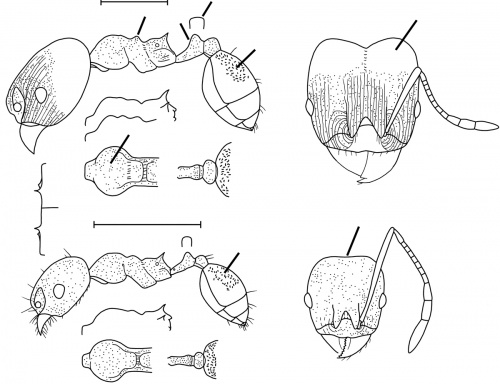Pheidole inversa
| Pheidole inversa | |
|---|---|

| |
| Scientific classification | |
| Kingdom: | Animalia |
| Phylum: | Arthropoda |
| Class: | Insecta |
| Order: | Hymenoptera |
| Family: | Formicidae |
| Subfamily: | Myrmicinae |
| Tribe: | Attini |
| Genus: | Pheidole |
| Species: | P. inversa |
| Binomial name | |
| Pheidole inversa Forel, 1901 | |
Nothing is known about the biology of inversa.
Identification
See the description in the nomenclature section.
Keys including this Species
Distribution
Northern lowland Colombia and Curaçao. (Wilson 2003)
Latitudinal Distribution Pattern
Latitudinal Range: 10.964° to -4.1°.
| North Temperate |
North Subtropical |
Tropical | South Subtropical |
South Temperate |
- Source: AntMaps
Distribution based on Regional Taxon Lists
Neotropical Region: Colombia (type locality).
Distribution based on AntMaps
Distribution based on AntWeb specimens
Check data from AntWeb
Countries Occupied
| Number of countries occupied by this species based on AntWiki Regional Taxon Lists. In general, fewer countries occupied indicates a narrower range, while more countries indicates a more widespread species. |

|
Estimated Abundance
| Relative abundance based on number of AntMaps records per species (this species within the purple bar). Fewer records (to the left) indicates a less abundant/encountered species while more records (to the right) indicates more abundant/encountered species. |

|
Biology
Castes
Worker
Minor
Images from AntWeb
   
| |
| Syntype of Pheidole radoszkowskii inversa. Worker. Specimen code casent0904319. Photographer Z. Lieberman, uploaded by California Academy of Sciences. | Owned by MSNG, Genoa, Italy. |
   
| |
| Syntype of Pheidole inversa. Worker. Specimen code casent0908103. Photographer Will Ericson, uploaded by California Academy of Sciences. | Owned by MHNG, Geneva, Switzerland. |
Major
Images from AntWeb
   
| |
| Syntype of Pheidole inversa. Worker (major/soldier). Specimen code casent0908102. Photographer Will Ericson, uploaded by California Academy of Sciences. | Owned by MHNG, Geneva, Switzerland. |
    
| |
| Syntype of Pheidole radoszkowskii inversa. Worker (major/soldier). Specimen code casent0904318. Photographer Z. Lieberman, uploaded by California Academy of Sciences. | Owned by MSNG, Genoa, Italy. |
Nomenclature
The following information is derived from Barry Bolton's Online Catalogue of the Ants of the World.
- inversa. Pheidole radoszkowskii var. inversa Forel, 1901e: 363 (s.w.) COLOMBIA. Raised to species: Wilson, 2003: 197.
Unless otherwise noted the text for the remainder of this section is reported from the publication that includes the original description.
Description
From Wilson (2003): A small reddish brown, nearly hairless member of the diligens group, close to Pheidole bruesi of Grenada, Pheidole diligens and Pheidole laidlowi of Brazil, and the widespread and very abundant Neotropical Pheidole radoszkowskii and Pheidole triconstricta. P. inversa is distinguished from all these species by the following combination of traits.
Major: anterior two-thirds of head longitudinally carinulate, posterior one-third smooth and shiny; cephalic rugoreticulum absent; petiolar node relatively thick in side view; anterior three-fourths of median strip of first gastral tergite shagreened and opaque. Minor: posterior two-thirds of median strip of first gastral tergite shagreened and opaque.
This form and Pheidole bruesi, as well as Pheidole diligens, may prove to fall within the substantial variation of Pheidole radoszkowskii and thus become synonymous.
MEASUREMENTS (mm) Lectotype major: HW 1.02, HL 1.08, SL 0.80, EL 0.20, PW 0.50. Paralectotype minor: HW 0.56, HL 0.64, SL 0.76, EL 0.16, PW 0.38.
COLOR Major: body light reddish brown; appendages brownish yellow.
Minor: concolorous light reddish brown.
Figure. Upper: lectotype, major (upper mesosomal profile, lectotype; lower mesosomal profile, major from Curaçao). Lower: paralectotype, minor. Scale bars = 1 mm.
Type Material
COLOMBIA: Barranquilla. Lectotype and paralectotype: National Museum of Natural History Paralectotypes: Musee d'Histoire Naturelle Genève - as reported in Wilson (2003)
Etymology
L inversa, turned upside down, allusion unknown. (Wilson 2003)
References
- Wilson, E. O. 2003. Pheidole in the New World: A dominant, hyperdiverse ant genus. Harvard University Press, Cambridge, MA. (page 197, fig. major, minor described; raised to species: new status)
- Camargo-Vanegas, J.J., Guerrero, R.J. 2020. Las hormigas Pheidole (Formicidae: Myrmicinae) en el bosque seco tropical de Santa Marta, Colombia. Revista Colombiana de Entomologia 46(2): e8433 (doi:10.25100/socolen.v46i2.8433).
- Forel, A. 1901j. Variétés myrmécologiques. Ann. Soc. Entomol. Belg. 45: 334-382 (page 363, soldier, worker described)
References based on Global Ant Biodiversity Informatics
- Kempf, W.W. 1972. Catalago abreviado das formigas da regiao Neotropical (Hym. Formicidae) Studia Entomologica 15(1-4).



